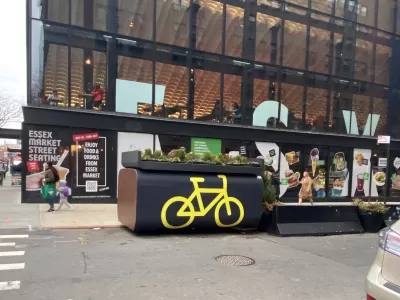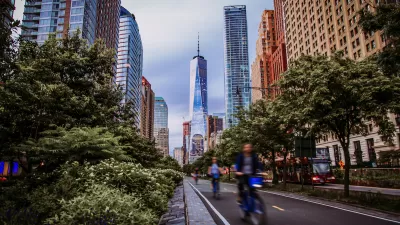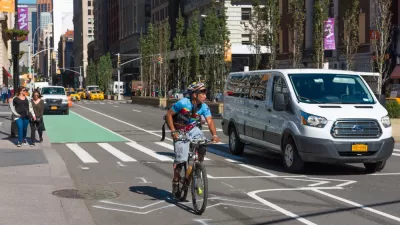While the city waits to evaluate data, advocates argue that recent demonstration projects have already proven the popularity of secure bike parking.

After six months of a successful secure bike parking program in a partnership with Oonee at locations around New York City, bike advocates are wondering what the holdup is.
According to a statement from the city’s Department of Transportation, “DOT stands by its commitment in the Streets Plan to continue exploring secure bike parking, and looks forward to reviewing the data from the Oonee demonstration.” Yet, according to an article by Gersh Kuntzman for Streetsblog NYC, “There’s already ample data on Oonee’s efficacy” in previous pilot programs.
The recent program, Kuntzman argues, will likely not show similarly robust results simply because “By the time locals figured out what the device was and how to use it, it was gone.” Anecdotally, people who used the secure parking expressed enthusiastic support for the service. “The need, and the public demand, for secure bike parking has long been documented, most recently in a Transportation Alternatives report that documented that a lack of safe places for bike parking not only reduces cycling, but reduces safety, increases theft (particularly to working cyclists) and hurts local businesses.”
A network of secure bike parking could also encourage more people to replace car trips with bike trips and lower their carbon footprint. “Earlier this year, a study on climate change mitigation by Cornell University’s School of Industrial and Labor Relations recommended the conversion of 5 percent of street parking spaces into 150,000 sheltered bike parking spaces by 2025.”
FULL STORY: After Successful Bike Parking Demo, DOT is Rightfully Being Asked, ‘What Now?’

Study: Maui’s Plan to Convert Vacation Rentals to Long-Term Housing Could Cause Nearly $1 Billion Economic Loss
The plan would reduce visitor accommodation by 25,% resulting in 1,900 jobs lost.

North Texas Transit Leaders Tout Benefits of TOD for Growing Region
At a summit focused on transit-oriented development, policymakers discussed how North Texas’ expanded light rail system can serve as a tool for economic growth.

Using Old Oil and Gas Wells for Green Energy Storage
Penn State researchers have found that repurposing abandoned oil and gas wells for geothermal-assisted compressed-air energy storage can boost efficiency, reduce environmental risks, and support clean energy and job transitions.

Private Donations Propel Early Restoration of Palisades Playground
Los Angeles has secured over $1.3 million in private funding to restore the Pacific Palisades playground months ahead of schedule, creating a modern, accessible space that supports community healing after recent wildfires.

From Blight to Benefit: Early Results From California’s Equitable Cleanup Program
The Equitable Community Revitalization Grant (ECRG) program is reshaping brownfield redevelopment by prioritizing projects in low-income and environmental justice communities, emphasizing equity, transparency, and community benefits.

Planting Relief: Tackling Las Vegas Heat One Tree at a Time
Nevada Plants, a Las Vegas-based nonprofit, is combating the city’s extreme urban heat by giving away trees to residents in underserved neighborhoods, promoting shade, sustainability, and community health.
Urban Design for Planners 1: Software Tools
This six-course series explores essential urban design concepts using open source software and equips planners with the tools they need to participate fully in the urban design process.
Planning for Universal Design
Learn the tools for implementing Universal Design in planning regulations.
Ascent Environmental
Borough of Carlisle
Institute for Housing and Urban Development Studies (IHS)
City of Grandview
Harvard GSD Executive Education
Toledo-Lucas County Plan Commissions
Salt Lake City
NYU Wagner Graduate School of Public Service





























